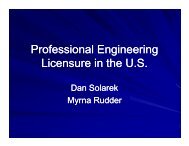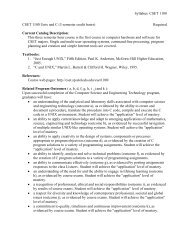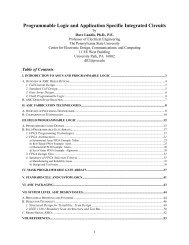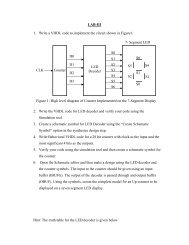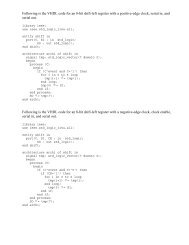MEPDG Presentation - The University of Toledo - Engineering ...
MEPDG Presentation - The University of Toledo - Engineering ...
MEPDG Presentation - The University of Toledo - Engineering ...
You also want an ePaper? Increase the reach of your titles
YUMPU automatically turns print PDFs into web optimized ePapers that Google loves.
By American Structurepoint, Inc.<br />
Cash Canfield, PE ccanfield@structurepoint.com<br />
Jason Koch, PE jkoch@structurepoint.com<br />
614-901-2235
What is <strong>MEPDG</strong>?<br />
Mechanistic-Empirical Pavement Design<br />
Guide by AASHTO<br />
Pavement analysis tool that uses project<br />
specific traffic, climate, and materials data for<br />
estimating damage accumulation over a<br />
specified pavement service life<br />
Design process based on predictive<br />
performance <strong>of</strong> a pavement section designed<br />
to predefined parameters identified as failing
Why use <strong>MEPDG</strong>?<br />
FHWA considers implementation <strong>of</strong> <strong>MEPDG</strong> a high<br />
priority as a critical element in improving the National<br />
Highway System<br />
Existing design procedures based upon 1950’s<br />
AASHO Road Test and use empirical relationships<br />
Current pavement designs <strong>of</strong>ten exceed the data<br />
limits and conditions used in the AASHO Road Test<br />
<strong>MEPDG</strong> provides a more realistic characterization <strong>of</strong><br />
in-service pavements and provides uniform<br />
guidelines for designing in-common features <strong>of</strong> all<br />
pavement types
AASHTO DARWin Method<br />
“Required” Structural Number ≤ “Design” Structural Number<br />
Inputs<br />
1. Design life (analysis period)<br />
2. Traffic (ESAL’s)<br />
3. Foundation stiffness (M r or<br />
CBR)<br />
4. Performance criteria (ΔPSI)<br />
5. Reliability (Z R and S o)<br />
Output<br />
1. Required Structural Number<br />
≤<br />
Inputs<br />
1. Structural Layer Coefficients<br />
2. Drainage Factor<br />
3. Layer Thickness<br />
Output<br />
1. Design Structural Number
AASHTO DARWin Method<br />
“Required” Structural Number ≤ “Design” Structural Number<br />
(structural coefficient)<br />
(drainage coefficient)
AASHTO DARWin Method<br />
Benefits <strong>of</strong> Use<br />
Quick calculation<br />
Data requirements<br />
Universal use<br />
Drawbacks <strong>of</strong> Use<br />
Not calibrated for<br />
regional use<br />
Climatic<br />
Materials<br />
Traffic<br />
Layer Coefficients<br />
Pass/Fail<br />
Empirical design from one test track (Ottawa, IL) in the 1950’s
<strong>MEPDG</strong> Method<br />
Climate<br />
Response<br />
Materials<br />
Damage<br />
Time<br />
Damage<br />
Accumulation<br />
Structure<br />
Traffic<br />
Distress
<strong>MEPDG</strong> Overview<br />
Mechanistic design – finite element analysis<br />
Research grade s<strong>of</strong>tware<br />
Local calibration is the key<br />
Does not “output” a design – your design is an<br />
“input” for analysis<br />
Expandable to new materials<br />
Narrowing down design life deviations
<strong>MEPDG</strong> Overview<br />
User Interface<br />
General Inputs<br />
Requirements from Designers<br />
Inputs provided by INDOT<br />
Traffic Inputs<br />
Requirements from Designers<br />
Inputs provided by INDOT<br />
Climatic Inputs<br />
Material Inputs<br />
Requirements from Designers<br />
Inputs provided by INDOT<br />
Performance Criteria<br />
Requirements from Designers<br />
Inputs provided by INDOT<br />
Outputs
<strong>MEPDG</strong> “Dashboard”
Inputs from Designer - General<br />
Design life<br />
expectancy<br />
Critical milestones<br />
Month <strong>of</strong> subbase<br />
construction<br />
Month <strong>of</strong> pavement<br />
construction<br />
Month that the road is<br />
opened to traffic<br />
Type <strong>of</strong> Design<br />
◦ New pavement<br />
◦ Restoration <strong>of</strong> JPCP<br />
◦ Overlay (HMA or PCC)<br />
Desired pavement type<br />
◦ Flexible (HMA)<br />
◦ Jointed Plain Concrete<br />
Pavement (JPCP)<br />
◦ Continuously Reinforced<br />
Concrete Pavement (CRCP)
Inputs from INDOT - General<br />
INDOT Design Life Expectancy<br />
INDOT Traffic Groups<br />
INDOT Assumed Milestones<br />
Base/Subgrade Construction Month: May<br />
Pavement Construction Month: July<br />
Traffic Open Month: September
Inputs from Designer - Traffic<br />
Roadway classification<br />
Truck traffic data – AADTT (current, future, & growth rate)<br />
Determination <strong>of</strong> Traffic Group (A, B, C, or D)<br />
Traffic direction (north/south or east/west)<br />
No. <strong>of</strong> lanes in design direction<br />
Determination <strong>of</strong> % trucks in design direction<br />
Determination <strong>of</strong> % trucks in design lane<br />
Posted Speed (not design speed)
INDOT Inputs - Traffic<br />
% Trucks in Design Lane<br />
% Trucks in Design Direction<br />
* Based on statewide WIM data<br />
Bottom Line: Lots <strong>of</strong> data<br />
collection & analysis by INDOT
Inputs from Designer - Climate<br />
Project location (latitude, longitude & elevation)<br />
Annual Average Water Table Depth<br />
LTPP Weather Stations
Inputs from Designer - Materials<br />
Soil Resilient Modulus (M R) –<br />
NOT CBR<br />
Untreated Subgrade – “Virgin”<br />
Material<br />
Treated Subgrade<br />
AASHTO Soil Classification<br />
FWD (Falling Weight<br />
Deflectometer) Testing if<br />
Structural Resurface<br />
Modulus <strong>of</strong> Subgrade Reaction<br />
(“k” value)<br />
Subgrade Treatment Type<br />
Underdrain Requirement<br />
Initial Pavement Design
Inputs from Designer - Materials<br />
Typical Sections - PCCP<br />
Fig. 52-13F: PCCP Section with PCCP Shoulder<br />
Fig. 52-13G: PCCP Section with HMA Shoulder
Inputs from Designer - Materials<br />
Typical Sections - HMA<br />
Fig. 52-13A: Full Depth HMA with Full Depth Shoulder<br />
Fig. 52-13B: Full Depth HMA with Composite Shoulder
Inputs from INDOT - Materials<br />
Subgrade Treatment as Determined by Geotechnical Engineer<br />
Type I<br />
14” <strong>of</strong> chemical soil modification, or<br />
12” <strong>of</strong> subgrade excavated and<br />
replaced with C.A. #53, or<br />
24” <strong>of</strong> soil compacted to density and<br />
moisture requirements<br />
Type IA<br />
14” <strong>of</strong> chemical soil modification, or<br />
12” <strong>of</strong> subgrade excavated and<br />
replaced with C.A. #53<br />
Type IB<br />
14” <strong>of</strong> chemical soil modification<br />
Type IC<br />
12” <strong>of</strong> subgrade excavated and<br />
replaced with C.A. #53<br />
Type II<br />
8” <strong>of</strong> chemical soil modification, or<br />
6” <strong>of</strong> subgrade excavated and<br />
replaced with C.A. #53, or<br />
12” <strong>of</strong> soil compacted to density and<br />
moisture requirements<br />
Type IIA<br />
8” <strong>of</strong> chemical soil modification, or<br />
6” <strong>of</strong> subgrade excavated and<br />
replaced with C.A. #53<br />
Type III<br />
6” <strong>of</strong> soil compacted to density and<br />
moisture requirements, or<br />
6” <strong>of</strong> subgrade excavated and<br />
replaced with C.A. #53<br />
Type IIIA<br />
6” <strong>of</strong> subgrade excavated and<br />
replaced with C.A. #53<br />
Type IV<br />
9” <strong>of</strong> subgrade excavated and<br />
replaced with C.A. #53 on geogrid
Inputs from INDOT - Materials<br />
In DARWin, the strength value (resilient modulus) <strong>of</strong> Subgrade<br />
Treatment and Subbase for PCCP were ignored<br />
o Only CBR <strong>of</strong> “virgin soil” used<br />
In <strong>MEPDG</strong>, subgrade & subbase are assigned strength values<br />
◦ Chemical soil modification<br />
◦ Compacted soil<br />
◦ C.A. #53<br />
◦ Virgin soil<br />
◦ Subbase for PCCP<br />
Subbase for PCCP<br />
◦ 3” <strong>of</strong> #8’s for Drainage Layer (25,000 psi)<br />
◦ 6” <strong>of</strong> #53’s for Separation Layer (30,000 psi)
Inputs from INDOT - Performance<br />
HMA Criteria PCCP Criteria
HMA Performance Criteria<br />
INDOT Criteria<br />
Terminal Roughness (IRI)<br />
Bottom-up Cracking / Alligator Cracking (Fig. 1)<br />
Permanent Deformation – Rutting (Fig. 2)<br />
<strong>The</strong>rmal Fracture (Fig. 3)<br />
Dependant on Classification & Reliability<br />
Fig. 1: Alligator Cracking Fig. 2: Rutting Fig. 3: <strong>The</strong>rmal Fracture
PCCP Performance Criteria<br />
INDOT Criteria<br />
Terminal Roughness (IRI)<br />
Transverse Slab Cracking (Fig. 4)<br />
Mean Joint Faulting (Fig. 5)<br />
Dependant on Classification & Reliability<br />
Fig. 4: Transverse Slab Cracking Fig. 5: Mean Joint Faulting
<strong>MEPDG</strong> Output




